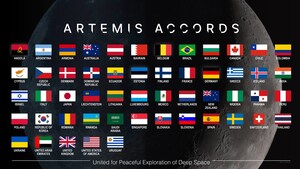HOUSTON, July 1, 2011 /PRNewswire-USNewswire/ -- University of Wisconsin students topped two other university teams to win the 2011 NASA eXploration Habitat (X-Hab) Academic Innovation Challenge – a competition to design and build a space habitat. The team will now take its inflatable space loft to NASA's annual Desert Research and Technology Studies (Desert RATS) field test in Arizona in September. It will be tested as part of a simulated astronaut mission to an asteroid.
(Logo: http://photos.prnewswire.com/prnh/20081007/38461LOGO )
"University students are helping NASA develop potential habitats for future space missions," said Kriss Kennedy, habitat demonstration unit project manager at Johnson. "The teams collaborated to demonstrate how technology we might use in the future could actually be developed."
The tree teams totaling 135 students each spent a week this month at NASA's Johnson Space Center in Houston setting up and deploying their inflatable lofts for judging. Teams from Oklahoma State University, Stillwater, and the University of Maryland, College Park also competed.
"This is a great example of how NASA can obtain innovative system concepts from universities," said Doug Craig, strategic analysis manager for analog systems at NASA Headquarters in Washington. "These technology concepts are a valuable part of our human space exploration planning activities."
According to the judges, the 14-member University of Wisconsin team's design held promise for habitability and application to the Desert RATS mission simulation and was ready for field use because it had little leakage in the inflatable systems. The loft will be part of the home for a crew of four during the field test.
In June 2010, NASA invited university teams to submit inflatable loft concepts for the X-Hab Challenge. The three competing universities received $48,000 of seed funding to assist with their projects. The winning university will receive $10,000 to offset costs associated with the desert field test.
Next year's competition, X-Hab 2012, will look at volume, geometry and habitability of a deep space habitat and technologies for plant growth and geo-science sample handling. The competition is designed to engage and retain students in the science, technology, engineering and math disciplines, which in turn will help develop the next generation of innovators and explorers. It also tests concepts and solutions for potential future NASA missions.
X-Hab is sponsored by NASA's Exploration Systems Mission Directorate and the Innovative Partnerships Office in the Office of the Chief Technologist at NASA headquarters in Washington. For more information about the X-Hab competition and updates about each team's designs, visit:
http://www.nasa.gov/exploration/analogs/xhab_challenge.html
SOURCE NASA
WANT YOUR COMPANY'S NEWS FEATURED ON PRNEWSWIRE.COM?
Newsrooms &
Influencers
Digital Media
Outlets
Journalists
Opted In




Share this article